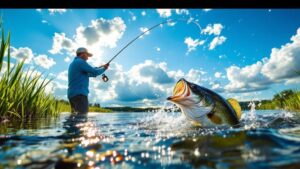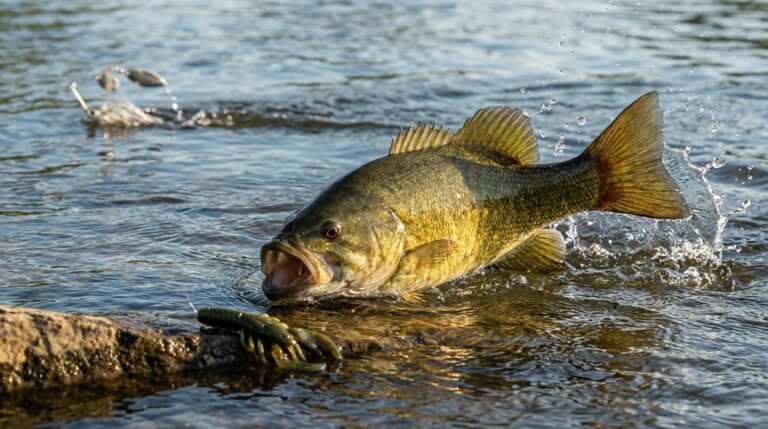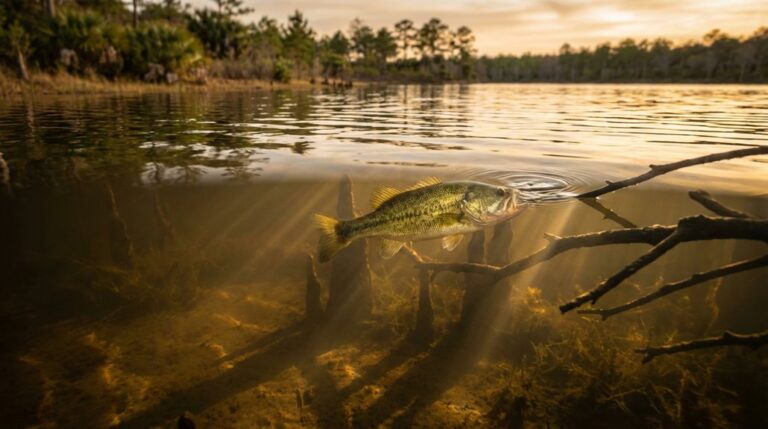To catch largemouth bass, you'll need a 7-foot medium-heavy rod paired with a quality spinning reel and proper line selection. Focus your fishing during dawn and dusk when bass are most active, targeting areas near cover like stumps, rocks, and vegetation. Use a mix of lures including crankbaits, spinnerbaits, and plastic worms, varying your retrieval speed based on water conditions. Understanding seasonal patterns and mastering advanced techniques will take your bass fishing to trophy levels.
Essential Gear and Setup for Bass Anglers
Success in largemouth bass fishing starts with the right equipment. As a bass angler, you'll need a 7-foot medium-heavy spinning rod paired with a Lews size 2000 spinning rod for ideal hook-setting and control.
Your fishing line choice matters: use 6-8 pound test Seaguar Invizx for better casting accuracy, or switch to 30-65 lb braided line when fishing in heavy cover.
Stock your tackle box with crucial lures, including plastic worms in green pumpkin and watermelon colors, crankbaits, and spinnerbaits.
Don't forget to pack various weights, hooks, pliers, and fish finders to handle any situation on the water. Understanding bass behavior can also greatly enhance your fishing success, as it allows you to tailor your approach based on their feeding patterns.
Before heading out, verify you're following fishing regulations by obtaining a valid fishing license.
This thorough setup will help you target largemouth bass effectively in different conditions.
Best Times and Conditions to Target Bass
When planning your bass fishing expedition, timing plays a crucial role in your success. You'll catch big largemouth bass most effectively during low light conditions at dawn and dusk when they're actively feeding.
During spring, particularly the prespawn period from March to May, bass become increasingly aggressive as they prepare for spawning.
For best results, target waters between 60-75°F, as this temperature range triggers peak feeding behavior.
Don't overlook night fishing during warm months, when bass often show heightened activity.
Environmental factors greatly influence your success rate – watch for approaching storm fronts, which can trigger feeding frenzies.
Additionally, pay attention to water clarity, as it affects bass movement patterns. Understanding optimal fishing conditions can significantly enhance your chances of a successful catch.
Popular Bass Fishing Methods and Strategies
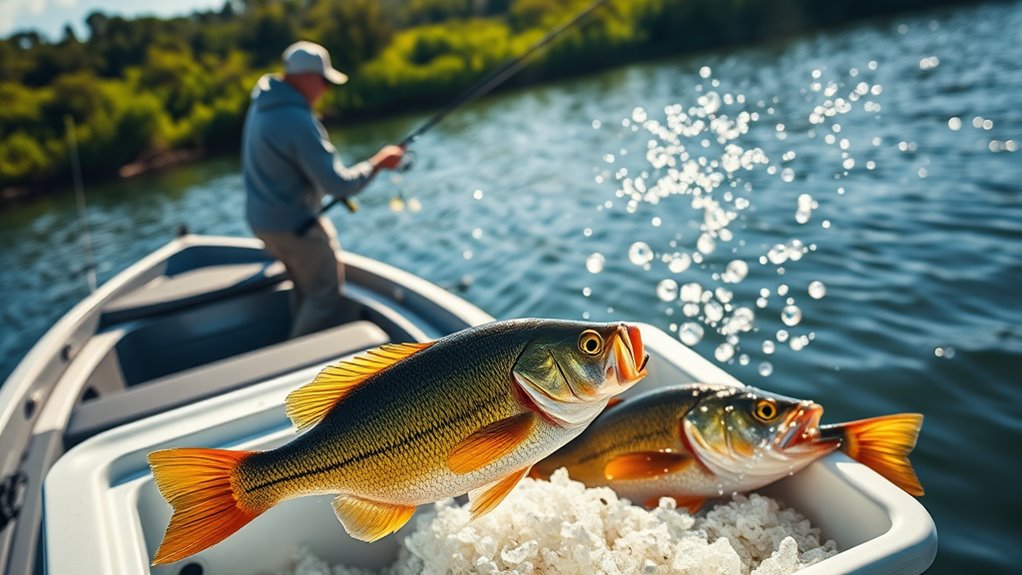
Mastering diverse fishing techniques will greatly boost your bass-catching potential. Each method offers unique advantages for different conditions, whether you're fishing in clear water or murky depths.
- Use crankbaits to trigger aggressive strikes with their noise and flash, even when bass aren't actively feeding.
- Work spinnerbaits through murky water, letting the rotating blades create enticing vibrations.
- Try drop shot rigs in deeper water, maintaining precise depth control with suspended soft plastic lures.
- Practice topwater fishing during dawn and dusk for explosive surface strikes.
- Employ jerkbaits with varied retrieve patterns, especially effective in cooler waters.
These techniques enhance your ability to adapt to changing conditions, and considering gear ratio can further optimize your lure presentation for different fishing scenarios.
Understanding Bass Behavior and Habitat
Knowledge of bass behavior and habitat is the foundation of successful fishing. You'll find these predators closely relating to cover like stumps, rocks, and vegetation, where they ambush their prey.
Bass behavior changes with water temperature, showing peak activity between 60-75°F, especially during dawn and dusk.
Understanding seasonal movement is essential for bass fishing success. During spawning, you'll locate males in shallow areas guarding nests, while females move in and out of the shallows.
After spawning, they'll shift to deeper depths as the water warms. In flowing waters, you can target bass in eddies and behind structure where they use current breaks to their advantage. Additionally, being aware of weather conditions can significantly enhance your chances of a successful catch.
Advanced Techniques for Trophy Bass
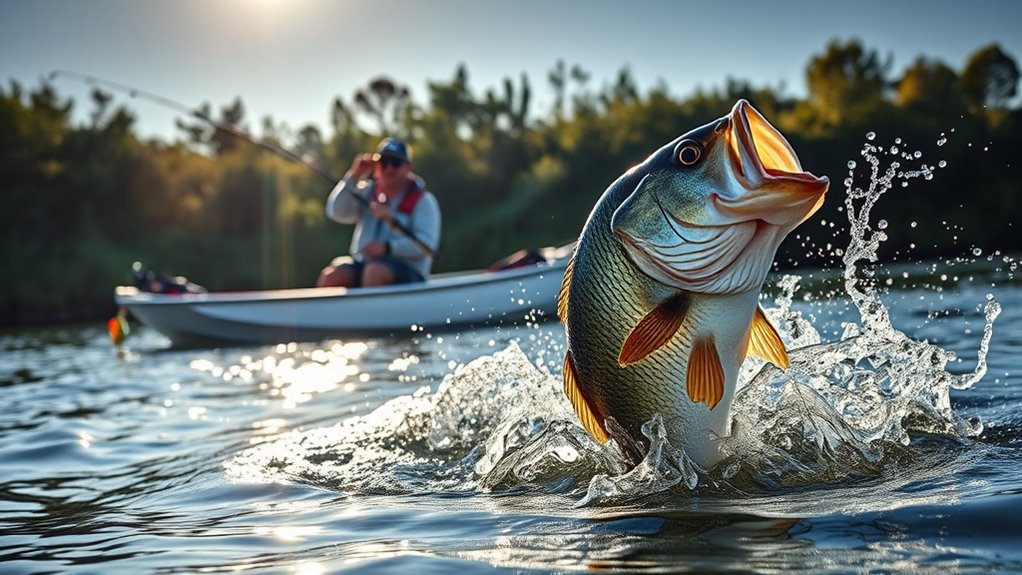
Building on your understanding of bass behavior, the pursuit of trophy largemouth requires specialized tactics and precision timing.
You'll need to master advanced techniques and target specific locations where these giants ambush their prey. To consistently catch trophy bass, focus on these proven strategies:
- Deploy large swimbaits and topwater frogs during prime feeding times at dawn and dusk
- Target areas with substantial cover like submerged logs, rocks, and thick vegetation
- Use carolina rigs with soft plastics to fish deeper water, especially post-spawn
- Vary your retrieve with jerkbaits, mixing erratic movements and strategic pauses
- Monitor seasonal patterns and weather conditions, particularly fishing before storms
When fishing for trophy bass, you'll find success by combining these techniques with patience and persistence.
Remember to adjust your approach based on water conditions and the fish's behavioral patterns.
Frequently Asked Questions
What Is the Best Method to Catch Largemouth Bass?
You'll catch more bass using plastic worms in dark colors, working them slowly near cover. Don't forget to try crankbaits and spinnerbaits when fish are active, and master pitching techniques for tight spots.
What Is the 80/20 Rule in Bass Fishing?
You'll catch 80% of your bass from 20% of your fishing spots and techniques. It's about focusing your efforts on the most productive areas and methods rather than spreading yourself too thin.
What Is the Best Bait for Largemouth Bass?
You'll find plastic worms, especially Berkeley 7" Power Worms in black/blue flake, are your top choice. For even better results, try live bait like crayfish, or use spinnerbaits when covering large water areas.
What Is the Easiest Bass Fishing Technique?
You'll find crankbaits are the easiest technique for catching bass. Just cast and retrieve at different speeds – there's no complex strategy needed. It's perfect for beginners and still gets plenty of strikes.
Final Thoughts
You're now equipped with the key knowledge to successfully target largemouth bass. Remember to match your gear, timing, and techniques to the conditions you're facing. Whether you're flipping jigs in heavy cover or working topwater lures at dawn, understanding bass behavior is essential. Keep practicing these methods, stay patient, and you'll soon be landing more and bigger bass on your fishing adventures.

